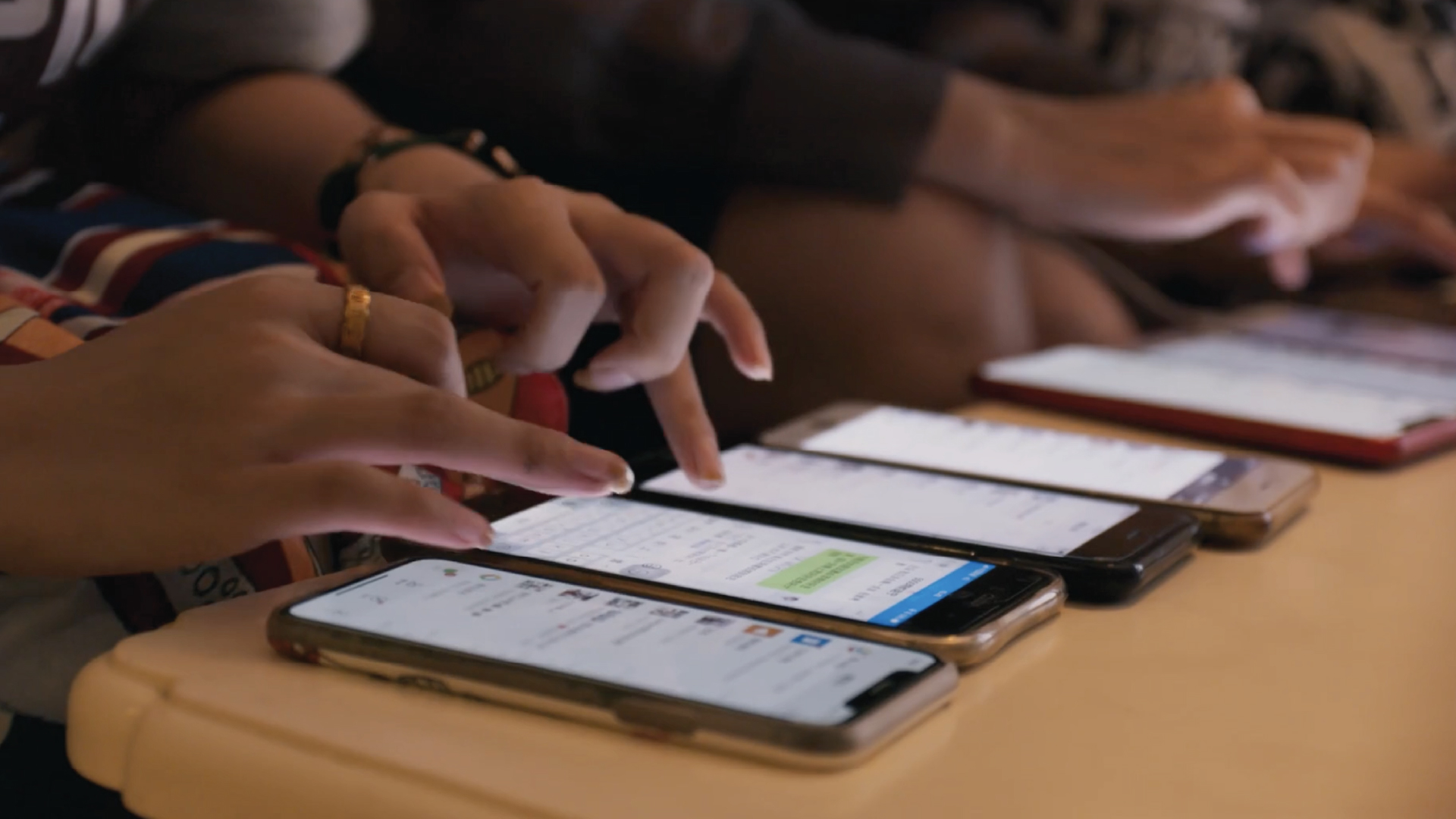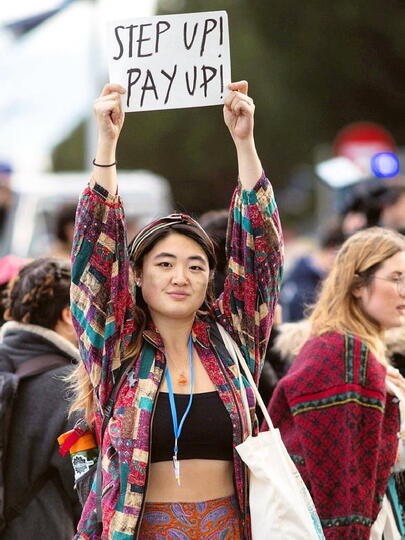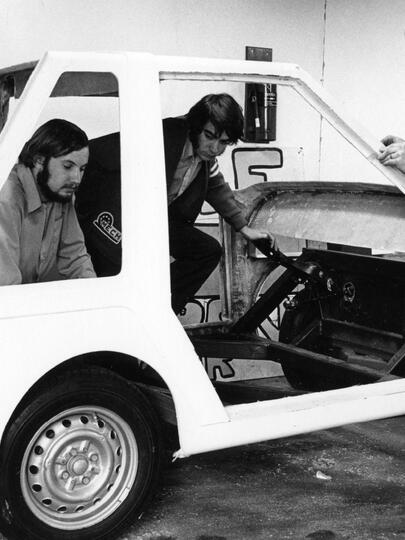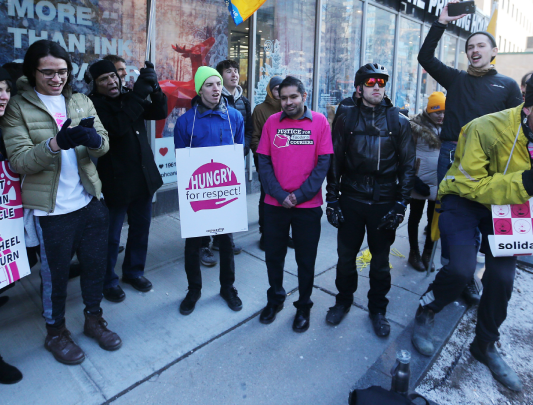
Illustration by Laurène Boglio
Humans in the loop
A UBC film prof’s new documentary offers a glimpse into a dystopian digital economy and the workers getting by one gig at a time.
In the opening shots of The Gig is Up, a new documentary by UBC film professor Shannon Walsh, a column of blue-clad delivery bikers in Beijing stand at attention chanting their sales lines: Please verify your order is correct! Please leave a good review!
We are then shown a rideshare driver sitting in San Francisco traffic. An on-demand carpenter assembling an IKEA wardrobe in a London suburb. An UberEats delivery biker zipping across Paris with a Big Mac. The montage finally comes to small-town Florida, where a gangly 30-something, arms patched with tattoos, stares into the glow of an old laptop.
“I can’t get a regular job because I got a mouth full of permanent gold teeth,” says Jason Edwards, taking a moment to grin for the camera before turning back to a list of online surveys, which he completes for a few dollars each.
Jason is a “human in the loop,” one of the hundreds of millions of organic, task-based workers nestled in platforms like Google, Amazon, and Tinder that make up the $5 trillion gig economy. Subtitled “A very human tech doc,” The Gig is Up tells the stories of small time workers around the world lured by the promise of a new economic frontier of flexibility and entrepreneurialism, only to find themselves surviving from gig to gig in a brutal, unregulated industry.
“So often what we see about tech imagines the workforce as 30-something white men in button-down shirts or T-shirts in Silicon Valley,” explains Shannon Walsh, who began shooting in 2019. “It takes for granted entirely the actual labour that is creating the conditions for these types of businesses to thrive.”

Many platform-based gig workers are completely invisible, performing small human tasks for Amazon and Google to fill in the gaps where the AI falls short. Others, with platforms like Uber and TaskRabbit, are visible. We see them, maybe exchange a few words. But Walsh, who intersperses shots of people frantically pedalling, driving, or drilling with customers idly scrolling through phone apps, gives the sense that even these interactions are unwanted noise – human static in an automated realm. The system can cut pay rates at any time. Workers can find their accounts deleted in an instant, for any number of system-determined reasons. The Gig is Up offers a glimpse into an almost sci-fi dystopia most of us only encounter when a guy in a bike helmet arrives with a sack of food.
A digital frontier
“The thing about companies being unregulated is that they can change their rates, they can change what your pay is, they have no responsibility to you whatsoever, and you have no recourse,” Walsh says.
Walsh travelled from California to Nigeria to China, and beyond, trying to grasp a new economic frontier that knows neither nation nor boundaries.
She follows delivery riders in Shenzhen, China, forced to square off in a physical turf war as their platforms vie for digital real estate. In Paris, Leila Ouadad, a single mother of two, blows through red lights on her bike just to make her deliveries on time, even though a colleague died in a crash just months before.
Other gig work is less visible. In one interview (that didn’t make the final cut), Walsh speaks with a man who spends his time curating people’s Google search results. In another scene, she interviews a man in Nigeria who uses his human eye to rate user photos on a dating app. Another spends his days on Mechanical Turk, a.k.a. MTurk, Amazon’s vast distributed labour network in which an army of users throughout the world performs tiny, subjective tasks for pennies each.
"Anything you can think of that would have a human mediating with a computer, what they call ‘human in the loop,’ it exists,” Walsh explains. “That’s why the idea that this kind of tech is taking over elements of all of our jobs is really a lot closer than people imagine. But there will always be people in that process.”
The tech workforce is often imagined as 30-something white men in button-down shirts in Silicon Valley. It takes for granted entirely the actual labour that is creating the conditions for these types of businesses to thrive.
Life, one gig at a time
Almost all of these workers agree on one thing: things used to be better.
In San Francisco, another single mother quit a steady job to drive for Uber and Lyft because the pay was high and the work was flexible. Then Uber dropped the rates.
“I was making really good money. We didn’t really have to think about ‘let’s go get a treat’ or ‘let’s go to the beach,’” the driver, Annette Rivero, says, breaking down in tears from behind the wheel. “I don’t even get to drive to go see my parents in Los Banos anymore because I can’t afford the gas.”
Rivero fell victim to a kind of winner-take-all phenomenon called the “network effect,” described in the film by Nick Srnicek, author of Platform Capitalism. Basically, services like Uber or Grubhub only work if they can become ubiquitous, and are willing to lose money in order to build an initial userbase. The result resembles a toxic romance: platforms seduce workers with steady gigs and artificially high pay, but when they reach critical mass, rates drop, and workers become disposable.
The Gig is Up and my conversation with Walsh inspired me to do a little first-hand reporting in my own neighborhood in New York City. I called a Lyft, and the driver turned out to be Ali Alghazali, an immigrant from Yemen who spent more than 25 years as a traditional taxi and limo driver before the rideshare wave all but obliterated the industry.

Alghazali’s story could have been one of Walsh’s deleted scenes: Like the drivers in the film, he earned decent money when he started, and he had the flexibility to help his wife take care of their six children. Then, as the network effect set in, rates plunged. He found himself working eight, then 10, then 12-hour shifts just to make ends meet.
“Back in the day – 2014, 2015 – you made good money. Uber didn't have so many drivers, you had surge prices,” he says, referring to Uber’s system of raising prices during peak hours. Over the years, Uber has reduced drivers’ cuts of surge fares even though prices remain the same. “Now Uber has maybe 25, 30 thousand cars in New York City. Uber cared about the drivers before. Right now? They don't care. They got so many drivers.”
Alghazali says he has clocked in more than 30,000 rides with thousands of five-star ratings. But it all counts for nothing when one bad customer, perhaps angry because he can’t drink or smoke in the car, types a complaint.
“They don't even ask you, they just deactivate your account. They close it right away."
He has always managed to get his account unlocked, but he hates the feeling that at any moment he could be deleted like a line of faulty code, with hundreds of other drivers to instantly take his place. He says that during the pandemic, when New York streets were empty and prices were at an all-time low, he once called Uber to try to negotiate a better deal.
“And do you know what he told me? Stop driving. Find some other employment.”
I ask him why he doesn’t do just that.
“I’m a driver, sir,” he says. “That’s my job.”
Closing the loop
Quitting, finding a traditional job with a traditional employer, seems simple from the outside. But Walsh says on-demand gig work has a way of spreading its roots into one’s daily life and routines. “You're constantly hustling,” she explains. “You don't have time to look side to side at what could be on the horizon, because you're just trying to get the next job. In that mode, you kind of get swallowed.”

Plus, there are problems with traditional work as well.
“It's hard to go back to someone and say, ‘This is very precarious work, but how about you work 9-to-5 with a manager who’s going to tell you to work Saturday even though it's your kid’s birthday?’ Nobody wants to go back to that,” Walsh says. “Labour has always been a space of contestation.”
Despite the dystopic images in her film, Walsh doesn’t believe the gig economy is a simple failed capitalist experiment. After all, it has allowed Jason Edwards, shut out of the mainstream labour market with his criminal record and gold teeth, a way back in. It has allowed Alghazali the freedom to log out and take care of one of his kids when they get sick without worrying if he’ll lose his job (even if it means working through the night to make up the loss).
"The creative intelligence of some of the people I met in Nigeria, for example, who might otherwise be inaccessible, but who are brilliantly creative, can now plug into this big human brain,” Walsh continues. “That's really cool. It can be amazing and it can be revolutionary.”
But there is a lot of work to be done.
The Gig is Up ends on a cliffhanger, with hundreds of Uber and Lyft drivers picketing and blocking roads in San Francisco to oppose California’s Proposition 22, which excluded them from certain protections and benefits. Their fight was ultimately unsuccessful, and Proposition 22 would eventually be passed.
But it was just the beginning.
“We're at the crest of a wave right now. We are literally at the very beginning of the workers’ movements for this stuff. And they’re already mobilizing a lot,” Walsh says. “I don’t think all is lost.”




































